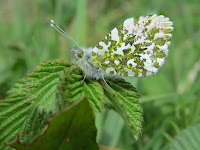This butterfly became extincted in the UK in 1979 but has now been successfully re-introduced at a few sties across the UK with Daneways being one of them.
The Large Blue is one of the most enigmatic butterflies, whose remarkable life cycle involves spending most of the year within the nests of red ants, where the larvae feed on ant grubs.
The butterflies at Daneways seem to favour a couple of places so I concentrated my search over these two areas, on my first visit I could only find one butterfly but with the conditions not being that great I know that I would need to return again in a few days time.
 |
| LARGE BLUE |
Next visit and the weather almost perfect I started out very hopeful, and not too long into my search a couple of butterflies flew passed me and landed a few feet away. A slow approach and you could soon see that they were Large Blues, further searching found around six to eight individuals some allowing a few photographs. So all in all a good day!.
My next visit about ten days later and again I only found one butterfly so over the course of about 25 days it looked like their season was over for another year.
This reserve is a wonderful place for butterflies and during my searches for the Large Blues I recorded 16 other species.DT
SMALL COPPER
|
| ORANGE TIP |






